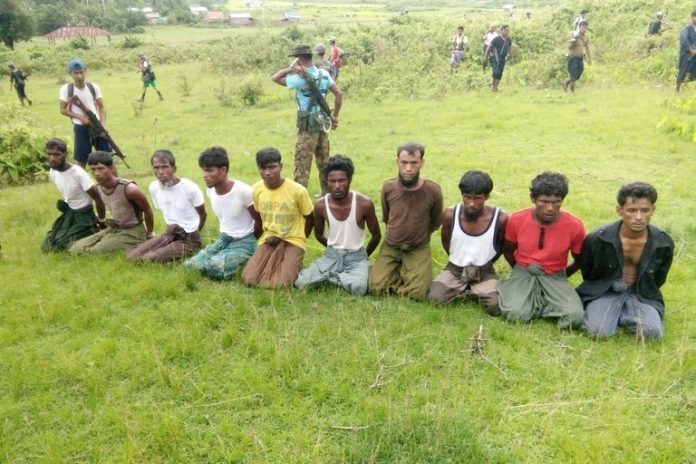The news agency Reuters has published a detailed investigation into the massacre of 10 Rohingya men by Myanmar soldiers and villagers, saying that the work led the Myanmar authorities to arrest two of its reporters.
The article, which was published on Friday, describes how soldiers and Buddhist villagers carried out the killings in September and buried the victims in a single grave. Based on eyewitness accounts, it includes photographs of the Rohingya men tied up and kneeling before their execution, and images after their deaths.
Pictures taken later show what appear to be human bone fragments at the site of the mass grave.
Two of the four journalists who worked on the report, U Wa Lone and U Kyaw Soe Oo, were arrested in December and face trial on charges of violating Myanmar’s colonial-era Official Secrets Act. They have been denied bail and face up to 14 years in prison.
The massacre described in the Reuters report occurred during a wave of attacks on the Rohingya Muslim minority in Rakhine State last year that Secretary of State Rex W. Tillerson said “constitutes ethnic cleansing.”
At least 6,700 Rohingya met violent deaths, including 730 children younger than 5, and hundreds of villages were destroyed as the military and Buddhist residents of the area sought revenge for deadly attacks on police posts by Rohingya insurgents.
About 700,000 Rohingya have fled across the border into Bangladesh to escape the violence.
In its 4,500-word article, Reuters documented the killings of the 10 Rohingya men in Inn Din village, about 30 miles north of Sittwe, the capital of Rakhine State.
The report identified the victims by name and described them as fishermen, shopkeepers and an Islamic teacher. Two were high school students. They ranged in age from 17 to 45.
At least two of the men were hacked to death by Buddhist villagers, and the rest were shot by Myanmar troops, Reuters reported, citing eyewitnesses who are Buddhist
“One grave for 10 people,” said U Soe Chay, 55, a retired soldier who told Reuters that he had helped to dig the grave and saw the killings. The soldiers shot each man two or three times, he said, but not all died immediately.

“When they were being buried, some were still making noises,” Reuters quoted him as saying. “Others were already dead.”
In January, the military confirmed that 10 Rohingya men were killed in Inn Din by villagers and soldiers. It said the men were terrorists who had attacked security forces, and that the soldiers had decided to kill them because intense fighting made it impossible to keep them in custody. The army said it would take action against those involved.
U Zaw Htay, a government spokesman, told Reuters, “We are not denying the allegations about violations of human rights.”
He added, “If we found the evidence is true and the violations are there, we will take the necessary action according to our existing law.”
Reuters said its report was based on scores of interviews with Rakhine Buddhist villagers, soldiers, paramilitary police officers, Rohingya Muslims and local administrators.
The villagers told Reuters that the military and the paramilitary police had organized Buddhist residents of Inn Din and at least two other villages to set fire to Rohingya homes, and that Buddhist villagers had participated in the killings of Rohingya in the area.
The government has accused Rohingya insurgents of burning the homes themselves.
Citing unidentified sources, the report said that an order to clear Inn Din had been passed down the military chain of command and that security forces wore civilian clothes to avoid being detected during raids.
Members of the paramilitary police looted Rohingya property, including motorcycles and cows, some of which were later taken by the military, Reuters reported.
None of the 6,000 Rohingya who once lived in Inn Din were still there by October.
The photographs of the 10 victims before and after the killings were provided by a Buddhist village elder who said he did not want to see the events repeated.
Mr. Wa Lone and Mr. Kyaw Soe Oo, the two journalists being held by the Myanmar authorities, had done extensive reporting on the massacre before they were arrested on Dec. 12. Reuters said Mr. Wa Lone had taken some photographs of the mass grave.
Human rights groups have accused the police of entrapping the two journalists by handing them documents. One relative said the two men had been seized so quickly that they did not have a chance to examine the documents.































